Home - Images - Products - Data - Publications - Contact
Click on the arrows within the index map below or go to the thumbnail images to view the perspective views. The views range from 136 to 184 kb.
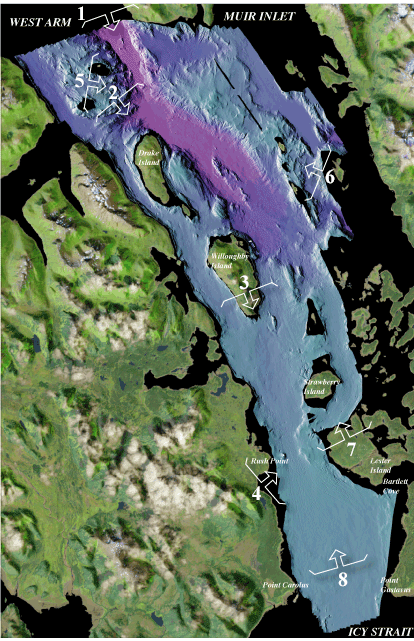
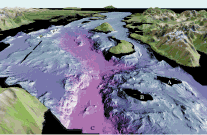
Larger View (184 kb) |
Figure 1. View looking south from the entrance of West Arm of Glacier Bay(arrow 1 on location map). The two prominent bedrock highs in the foreground are Geike Rock (A) and Lone Island (B). The terminus of the Little Ice Age glacier was at the approximate location of (C) in the 1860's. The distance across the bottom of the image is about 10 km (6.2 miles), vertical exaggeration is 2X. |
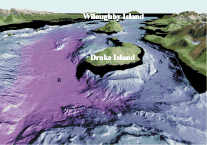
Larger View (172 kb) |
Figure 2. View looking southeast (arrow 2 on location map). Whidbey Passage (A) runs between Drake Island and the mainland and extends south along Willoughby Island. The Main Passage (B) runs east of Drake Island. Whidbey Passage is a glacially carved passage that varies in water depth from 95 m to 170 m (310 ft to 560 ft) along its axis, whereas the main passage varies in water depth from 250 m to 350 m (820 ft to 1150 ft) along its axis in this image. A glacier terminus was located near Willoughby Island in the mid 1800's. The distance across the bottom of the image is about 5 km (3.1 miles), vertical exaggeration is 2X. |
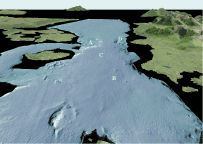
Larger View (144 kb) |
Figure 3. View looking south from over Willoughby Island toward Sitakaday Narrows (A) (arrow 3 on location map). The entrance to Glacier Bay at Icy Strait is in the distance. Iceberg wallow pits can be seen at (B), whereas ice gouges (C) extend south through and beyond Sitakaday Narrows. A bedrock knob (D) on the west side of the Narrows shoals to about 6 m (20 ft). The distance across the bottom of the image is about 5 km (3.1 miles), vertical exaggeration is 2X. |
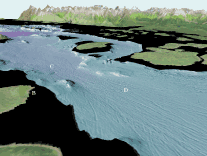
Larger View (156 kb) |
Figure 4. Sitakaday Narrows viewed towards the northeast showing a bedrock knob (A) off Rush Point (B) (arrow 4 on location map). Iceberg wallow pits (C) and gouges (D) show changes in travel paths of icebergs due to tidal current effects. The wallow pits can be as deep as 5 m (16 ft), whereas the gouges can be as deep as 2.5 m (8 ft). The distance across the bottom of the image is about 2.5 km (1.5 miles), vertical exaggeration is 2X. |

Larger View (180 kb) |
Figure 5. View looking east from the West Arm of Glacier Bay (arrow 5 on location map). A bedrock high (A) extends northwest from the Marble Islands (B). The slope at C to C' drops from about 100 m to 325 m (328 ft to 1070 ft). Drake Island marks the west side of Glacier Bay main passage. The distance across the bottom of the image is about 3.3 km (2.0 miles), vertical exaggeration is 2X. |

Larger View (168 kb) |
Figure 6. View looking northwest over North (A) and South (B) Marble Islands (arrow 6 on location map). These islands are part of a bedrock high (C) that runs northwest to southeast within Glacier Bay. Glacier Bay main passage (D) is to the west of the bedrock high, whereas Beartrack Cove deep (E) is to the east. The opening to the north (F) is the entrance to the West Arm of Glacier Bay. The distance across the bottom of the image is about 3.5 km (2.2 miles), vertical exaggeration is 2X. |
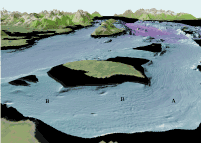
Larger View (140 kb) |
Figure 7. View of Glacier Bay looking northwest over Strawberry Island (arrow 7 on location map). Iceberg gouges (A) turn the corner around Strawberry Island and bend southwest toward the main passage. Depressions at (B) may be wallow pits formed where iceberg keels moved up and down during one or more tidal cycles. The distance across the bottom of the image is about 4.5 km (6.1 miles), vertical exaggeration is 2X. |
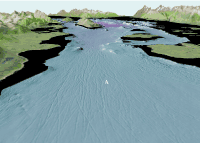
Larger View (136 kb) |
Figure 8. View of the entrance to Glacier Bay looking north (arrow 8 on location map). The terminus of the Little Ice Age glacier was at the bottom of this image in 1794 when Vancouver's exploration discovered the glacier. Linear gouges (A) are likely caused by icebergs grounded on the coarse bottom sediment of Sitakaday Narrows. The bergs were pushed through the Narrows by tidal currents that can reach speeds as fast as 7 knots. The distance across the bottom of the image is about 4.5 km (2.8 miles), vertical exaggeration is 2X. |